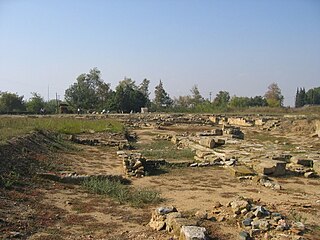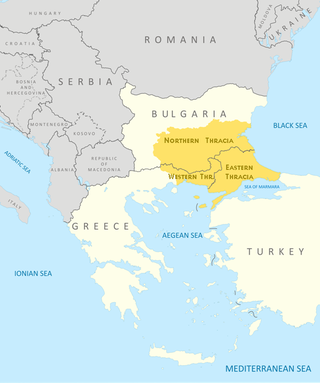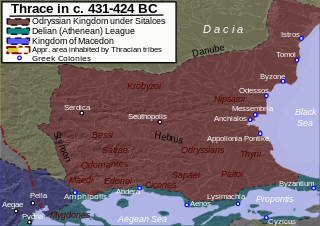Related Research Articles

Abdera is a municipality in the Xanthi regional unit of Thrace, Greece. In classical antiquity, it was a major Greek polis on the Thracian coast.

Thrace is a geographical and historical region in Southeast Europe. Bounded by the Balkan Mountains to the north, the Aegean Sea to the south, and the Black Sea to the east, it comprises present-day southeastern Bulgaria, northeastern Greece, and the European part of Turkey, roughly the Roman Province of Thrace. Lands also inhabited by ancient Thracians extended in the north to modern-day Northern Bulgaria and Romania and to the west into Macedonia.
Heraclides, Heracleides or Herakleides in origin was any individual of the legendary clan of the Heracleidae, the mythological patronymic applying to persons descended from Hercules. As they were of the legendary tribe of the Dorians, the name in the classical age could mean anyone of Dorian background. The Dorians had their own group of dialects, which may or may not have been spoken by given individuals. Usage of the name was concentrated at Syracuse, a Dorian colony, Tarentum, a Spartan colony, and central Greece, legendary ancestral homeland of the Dorians, but they colonized the islands, Crete, and Anatolia as well. As a personal name, Heraclides may refer to:

Eastern Macedonia and Thrace is one of the thirteen administrative regions of Greece. It consists of the northeastern parts of the country, comprising the eastern part of the region of Macedonia along with the region of Western Thrace, and the islands of Thasos and Samothrace.

The Odrysian kingdom was an ancient Thracian state that thrived between the early 5th century BC and the early 3rd / late 1st century BC. Located in present-day Bulgaria, southeastern Romania, northern Greece and European Turkey, it was a tribal amalgam dominated by the Odrysians that was the first large political entity to develop in the eastern Balkans.
Cardia or Kardia, anciently the chief town of the Thracian Chersonese, was situated at the head of the Gulf of Melas. It was originally a colony of the Milesians and Clazomenians; but subsequently, in the time of Miltiades, the place also received Athenian colonists, as proved by Miltiades tyranny. But this didn't make Cardia necessarily always pro-Athenian: when in 357 BC Athens took control of the Chersonese, the latter, under the rule of a Thracian prince, was the only city to remain neutral; but the decisive year was 352 BC when the city concluded a treaty of amity with king Philip II of Macedonia. A great crisis exploded when Diopeithes, an Athenian mercenary captain, had in 343 BC brought Attic settlers to the town; and since Cardia was unwilling to receive them, Philip immediately sent help to the town. The king proposed to settle the dispute between the two cities by arbitration, but Athens refused. Demosthenes, the famous Greek patriot and orator, spoke on this very matter to the Athenian Senate in 341 BC his "Oration On The State Of The Chersonesus":
Our present concernment is about the affairs of the Chersonesus, and Philip's expedition into Thrace...but most of our orators insist upon the actions and designs of Diopithes...which, if one moment neglected, the loss may be irreparable; here our attention is instantly demanded...shall Philip be left at full liberty to pursue all his other designs, provided he keeps from Attica; and shall not Diopithes be permitted to assist the Thracians? And if he does, shall we accuse him of involving us in a war?...none of you can be weak enough to imagine that Philip's desires are centered in those paltry villages of Thrace...and has no designs on the ports...arsenals...navies...silver mines, and all the other revenues of Athens; but that he will leave them for you to enjoy...? Impossible! No; these and all his expeditions are really intended to facilitate the conquest of Athens....let us shake off our extravagant and dangerous supineness; let us supply the necessary expenses; let us call on our allies...so that, as he hath his force constantly prepared to injure and enslave the Greeks, yours too may be ever ready to protect and assist them.
Cersobleptes was the son of Cotys I, king of the Odrysians in Thrace, on whose death in September 360 BC he inherited the throne.
Miltiades the Elder was an Athenian politician from the Philaid family. He is most famous for travelling to the Thracian Chersonese where, at the behest of the local peoples, he ruled as a tyrant. During his reign, Miltiades' best-attested action was the construction of a defensive wall across the peninsula.

Enez is a town in Edirne Province, in East Thrace, Turkey. The ancient name of the town was Ainos, Latinised as Aenus. It is the seat of Enez District. Its population is 4,301 (2022). The mayor is Özkan Günenç (CHP).
Bisanthe was a great city in ancient Thrace, on the coast of the Propontis, which had been founded by the Samians. About 400 BCE, Bisanthe belonged to the kingdom of the Thracian prince Seuthes II. At a later period its name was changed into Raedestum, Rhaedestum or Rhaideston (Ῥαίδεστον), or Raedestus, Rhaedestus or Rhaidestos (Ῥαίδεστος); but when this change took place is unknown. In the 6th century CE, the emperor Justinian did much to restore the city, which seems to have fallen into decay; but after that time it was twice destroyed by the Bulgarians, first in 813, and a second time in 1206. The further history of this city, which was of great importance to Byzantium, was covered by Byzantine historians George Pachymeres and Cantacuzenus. It is generally believed that the town of Resistos or Resisto, mentioned by Pliny the Elder, and in the Antonine Itinerary, is the same as Bisanthe; but Pliny mentions Bisanthe and Resistos as distinct towns. Coins minted by Bisanthe survive. Under the name Rhaedestus, it remains a titular see of the Roman Catholic Church.
Nymphodorus of Abdera was a citizen of Abdera, Thrace whose sister married Sitalces, a king of Thrace. The Athenians, who had previously regarded Nymphodorus as their enemy, made him their Proxenos in 431 BC, and, through his mediation, obtained the alliance of Sitalces, for which they were anxious, and conferred the freedom of their city on Sadocus, Sitalces' son. Nymphodorus also brought about a reconciliation between the Athenians and Perdiccas II, king of Macedon, and persuaded them to restore to him the town of Therma, which they had taken in 432 BC. In 430 BC, Nymphodorus aided in the seizure, at Bisanthe, of Corinthian Aristeus and the other ambassadors, who were on their way to ask aid of the Persian king against the Athenians.

Greek colonisation refers to the expansion of Archaic Greeks, particularly during the 8th–6th centuries BC, across the Mediterranean Sea and the Black Sea.
Drys was an ancient Greek town of ancient Thrace.
Zone was an ancient Greek polis on the Aegean coast of ancient Thrace on a promontory of the same name, a short distance to the west of the entrance of the Lacus Stentoris.
Pactya or Paktye was an ancient Greek city located in ancient Thrace, on the Thracian Chersonesus. It is cited in the Periplus of Pseudo-Scylax, in its recitation of the towns of the Thracian Chersonesus, along with Aegospotami, Cressa, Crithote and then Pactya, situated 36 stadia from Cardia. It is said that Miltiades founded it. Strabo places it on the Propontis between Crithote and Macron Teichos. According to Herodotus, Miltiades the Elder ordered a wall built between Cardia, which was on the coast of Gulf of Melas and Pactya, which was on the Propontis side, to prevent invasion of the Chersonesus by the Apsinthii. Alcibiades retired here the Athenians had for the second time deprived him of the command. It was a member of the Delian League. Pliny the Elder points out that both Cardia and Pactya later joined to form Lysimachia.

The members of the Delian League/Athenian Empire can be categorized into two groups: the allied states (symmachoi) reported in the stone tablets of the Athenian tribute lists, who contributed the symmachikos phoros in money, and further allies, reported either in epigraphy or historiography, whose contribution consisted of ships, wood, grain, and military assistance; proper and occasional members, subject members and genuine allies.
The Philaidae or Philaids were a powerful noble family of ancient Athens. They were conservative land owning aristocrats and many of them were very wealthy. The Philaidae produced two of the most famous generals in Athenian history: Miltiades the Younger and Cimon.
Serrheum or Serreion, or Serrhium or Serrion (Σέρριον), was a town on the southern coast of ancient Thrace, on a promontory of the same name. It lay to the west of Maroneia, and opposite to the island of Samothrace. It is repeatedly mentioned by Demosthenes, as having been taken by Philip II of Macedon (346 BCE), contrary to his engagements with the Athenians; and Livy states that it was one of the Thracian towns captured by Philip V of Macedon in the year 200 BCE.
References
- ↑ Paul Kretschmer. Die Griechischen Vaseninschriften ihrer Sprache nach untersucht.
- ↑ Miller, Stephen Gaylord (1991). Arete: Greek Sports from Ancient Sources. University of California Press. p. 86. ISBN 0-520-07509-9.